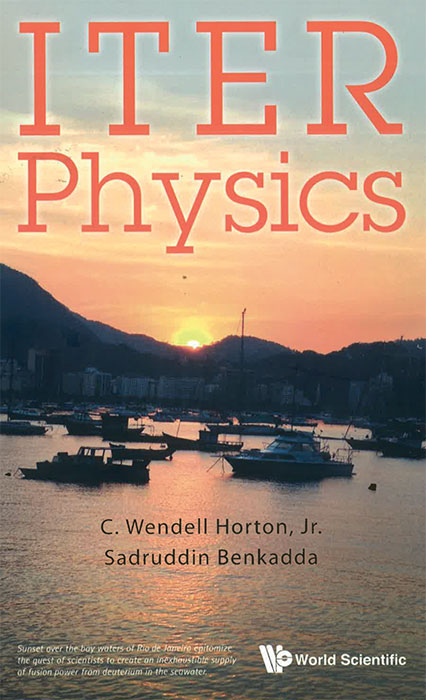By C Wendell Horton Jr and Sadruddin Benkadda
World Scientific

This 235 page book is dedicated to the ITER tokamak, the deuterium–tritium fusion reactor under construction in France, which aims to investigate the feasibility of fusion power. The book provides a concise overview of the state-of-the-art plasma physics involved in nuclear-fusion processes. Definitely not an introductory book – not even for a plasma-physics graduate student – it would be useful as a reference text for experts. Across 10 chapters, the authors describe the physics learned from previous tokamak projects around the world and the application of that experience to ITER.
After an introduction to the ITER project, the conventional magneto-hydrodynamic description of plasma physics is discussed, with strong emphasis on the geometry of the divertor (located at the bottom of the vacuum vessel to extract heat and reduce contamination of the plasma from impurities). Chapter 3 deals with the problem of alpha-particle distribution, which is a source of Alfven and cyclotron instabilities. Edge localised mode (ELM) instabilities associated with the divertor’s magnetic separatrix are also discussed. Conditions of turbulent transport are assumed throughout, so chapter 4 provides a general review of our (mainly experimental) knowledge of the topic. Chapters 5 and 6 are specific to the ITER design because they describe the ELM instabilities in the ITER tokamak and the solutions adopted for their control. Concluding the part dedicated to the fusion-reactor transient phase, steady-state operations and plasma diagnostics techniques are described in chapters 7 and 8, respectively.
The tokamak’s complex magnetic field is able to confine charged particles in the fusion plasma but not neutral particles. Neutron bombardment of surfaces can be viewed as an inconvenience, making it necessary to ensure the walls are radiation hard, or an advantage, turning the surfaces into a breeding blanket to generate further tritium fuel. Radiation hardness of the tokamak walls is discussed in chapter 9, while chapter 10 explains how ITER will transmute a lithium blanket into tritium via bombardment with fusion neutrons. The IFMIF (International Fusion Materials Irradiation Facility) project, conceived for fusion-material tests and still in its final design phase, is also briefly presented. The book closes with some predictions about the expectations to be fulfilled by ITER, before proceeding to the design of DEMO – a future tokamak for electrical-energy production.
In summary, ITER Physics is a book for expert scientists who are looking for a compact overview of the latest advances in tokamak physics. I appreciated the exhaustive set of references at the end of each chapter, since it provides a way to go deeper into concepts not exhaustively explained in the book. Plasma-fusion physics is complex, not only because it is a many-body problem but also because our knowledge in this field is limited, as the authors stress. I would have appreciated more graphic material in some parts: in order to fully understand how a fusion reactor works, one has to think in 3D, so schematics are always helpful.








